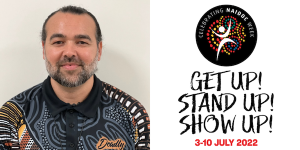1:30min
 Pictured above: Shaun Tatipata (Image source: Australian of the Year Awards)
Pictured above: Shaun Tatipata (Image source: Australian of the Year Awards)
Shaun Tatipata, the founding Director of Australia’s first Aboriginal-owned optical and eye care provider, Deadly Vision Centre, has a strong vision for the future of Indigenous eye health.
The Aboriginal business promotes health and wellbeing, while also celebrating Aboriginal and Torres Strait Islander culture and community. Their goal is to contribute to closing the gap in eye health for Aboriginal and Torres Strait Islander Australians by providing access to culturally safe and socially responsive eye care.
Shaun, who is of Wuthathi and Ngarrindjeri descent, has gained extensive experience in delivering primary health care and designing and implementing outreach programs in Indigenous communities. He is passionate about ensuring that Aboriginal and Torres Strait Islander people are able to access eye care services that are delivered to them by their community.
Here he speaks of his achievements and mission to help his community, and his ideal vision for the future of Aboriginal and Torres Strait Islander eye health.
What do you want to achieve most with the Deadly Vision Centre?
My goal is to ensure that our community has access to affordable and appropriate eye care for generations to come. Through this, I hope to create opportunities for other Aboriginal and Torres Strait Islander people to contribute positively to our community’s eye care needs and eventually get to a stage where we can train, equip and support others to advance the eye health of their own communities.
What’s your proudest achievement with Deadly Enterprises?
The whole journey has been incredible, but the establishment of the Deadly Vision Centre has to be one of the proudest moments and a highlight of my 20+ year career in Aboriginal and Torres Strait Islander health.
But the journey to get there is what makes it so special. With the support of my community, a bunch of amazing volunteers and some like-minded individuals and organisations, I was able to organise a Rugby League carnival during NAIDOC week and raise money by selling merchandise. The funds we raised were then used to set up the Deadly Vision Centre and we commenced delivering eye care two weeks later!
I am pleased to advise that the Rugby league Carnival is now an annual event (Deadly Cup Carnival) and it has quickly become one of the largest NAIDOC celebrations in the Northern Territory. It’s a living example of this year’s NAIDOC theme. We got up, we stood up, and our community showed up to help us progress our vision for a better tomorrow.
How do you see optometrists getting more involved in this space?
Optometrists at all stages of their career can contribute positively to advancing eye health outcomes for Aboriginal and Torres Strait Islander communities. These good intentions however need to match with the knowledge and skills, and even the partnerships necessary to deliver culturally safe eye care.
Undertaking cultural safety training and understanding the history and the protocols of the Aboriginal and Torres Strait Islander community you seek to serve is a great start – but fundamental to operating in this space is a strong and respectful relationship with the community and its Aboriginal Community Controlled Health Service (ACCHS).
These relationships can be forged by establishing a formal partnership with your local ACCHSs or Aboriginal and Torres Strait Islander people committed to advancing eye health outcomes in their community, and by participating in community activities where friendships can be made, and trust can be built.
And as more ACCHSs are empowered to lead the delivery of eye care in their communities, the need for optometrists with expertise in establishing sustainable eye care service models will grow. This shift in how eye care services are delivered will be key to advancing eye health outcomes for Aboriginal and Torres Strait Islander people and importantly, it will present new and exciting opportunities for the profession.
What are some sustainable actions you believe will help to improve eye health outcomes for Aboriginal and Torres Strait Islander peoples?
To improve eye health outcomes for Aboriginal and Torres Strait Islander people, we need to ensure access to culturally safe eye care regardless of where people live. This can be assisted by equipping and training local Aboriginal and Torres Strait Islander Health Workers/Practitioners to deliver eye care in the absence of visiting providers and through better utilising technology such as telehealth.
In larger communities, the resourcing of ACCHSs and other Aboriginal-led service providers with the workforce and equipment needed to establish a sustainable eye care service model would lead to increased access to culturally safe eye care and the ability to redesign the pathways to treatment.
What’s your vision for the future of Aboriginal and Torres Strait Islander eye health?
Sustainable eye care services delivered by our communities for our communities. The establishment of sustainable models of Aboriginal-led eye care and the engagement of optometrists to work alongside our Aboriginal and Torres Strait Islander Health Workers/Practitioners is the future of Aboriginal and Torres Strait Islander eye health. It is something that I am working on in my own community and something I am passionate about supporting other Aboriginal and Torres Strait islander people to achieve in their own communities.
Tagged as: Indigenous eye health